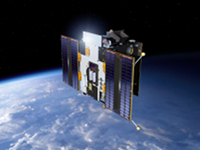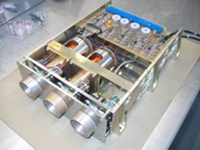First release of calibrated LYRA data from PROBA2
10 March 2011
The first calibrated measurements of solar irradiance made by the LYRA instrument on ESA's second PROBA (PRoject for On-Board Autonomy) satellite are now available to the scientific community. Future access to near-real-time data from both of the primary instruments on PROBA2, SWAP and LYRA, is expected to provide new opportunities to study solar activity and space weather. |
| ESA's PROBA-2 spacecraft |
SWAP is an extreme ultraviolet (EUV) telescope that provides images of the Sun's multimillion degree corona every about two minutes - seven times faster than the EIT instrument on the ESA-NASA SOHO spacecraft. It is able to observe phenomena associated with the birth of solar flares and huge eruptions of plasma known as coronal mass ejections (CMEs).
Acting as a solar monitor, SWAP is capable of recording the evolution over time of every event in the low solar corona that might be of relevance to space weather. Its images provide important information on the location of coronal holes (the source of high speed solar wind streams), active regions (a potential source of solar flares) and filaments (potential eruption sites). Collected data are buffered onboard so that the latest images with highest priorities are sent to ground first. Priorities are allocated in order to guarantee complete time coverage and full telemetry use.
 |
| The LYRA instrument on PROBA-2 |
This means that the solar output in different UV bands is sampled at least once every 50 milliseconds. Such rapid sampling makes it possible to see how energy is released during solar events.
"LYRA comprises three redundant groups of detectors, each capable of measuring solar irradiance in four key UV spectral bands," said Marie Dominique of the Royal Observatory of Belgium, Principal Investigator for LYRA.
"Most are made of diamond, instead of silicon – the first time such detectors have been used in space. This means that they are less affected by Earth's radiation belts, particularly the South Atlantic Anomaly. By using diamond photodetectors, the number of filters required to block unwanted visible radiation can also be reduced and serious attenuation of the desired UV radiation can be minimised."
"LYRA is complementary to SWAP and to instruments on other missions," she added. "We can study variations in the UV flux with LYRA, and then try to find the spatial origin of the flux with SWAP."
Calibrated SWAP data has been available for some time, but until now only the LYRA engineering data has been available. Although this uncalibrated data can be used to detect UV variability, it does not provide absolute values.
| Complementary LYRA and SWAP measurements of two flaring events: (left) 7 June and (right) 18 October 2010. | |
"There have already been some studies of oscillations in the flux during flares," said Marie Dominique. "These provide information on the physical phenomena occurring during flare initialization."
"LYRA has also been used to look at the Sun through Earth's upper atmosphere, and the degree of attenuation will provide information about the composition, density and layering of the atmosphere."
"In future, we expect to be able to conduct a temporal and spectral analysis of solar flares, and establish the contribution of UV to overall solar irradiance. We will also be able to characterise the corona as its UV output is gradually extinguished during eclipses."
To date, three guest investigators have also used LYRA data to look for the source of solar variability, to reconstruct solar events and for cross-calibration between LYRA and other missions. However, the availability of calibrated LYRA data will open up many new possibilities.
"We are very much looking forward to using the calibrated LYRA data," said Matthieu Kretzschmar, scientific collaborator from the Laboratory of Physics and Chemistry of the Earth and Space Environment, Orléans, France. "This will be important in enabling us to compare the data from the two instruments and to analyse the active processes taking place on the Sun."
The LYRA data will be available in FITS file format, with plots in jpg and png formats, and can be accessed via the PROBA-2 Science Centre.
Background
The LYRA instrument was designed, manufactured and calibrated by a Belgian-Swiss-German consortium, with the Royal Observatory of Belgium as the principal investigator, PMOD/WRC as lead co-investigator, and Centre Spatial de Liège as project manager.
PROBA-2 carries 17 separate technology experiments and four scientific instruments to observe the Sun and study Earth's plasma environment. In addition to SWAP and LYRA, it carries two plasma measurement instruments: the Thermal Plasma Measurement Unit (TPMU) and the Dual Segmented Langmuir Probe (DSLP).
PROBA-2 was launched along with ESA's Soil Moisture and Ocean Salinity (SMOS) mission on 2 November 2009.
Contacts
Marie Dominique
LYRA Principal Investigator
Royal Observatory of Belgium
Phone: +32 2 373 02 89
Email: marie.dominique oma.be
oma.be
Joe Zender
ESA PROBA-2 Science Coordinator
Science Operations Department
Directorate of Science and Robotic Exploration.
Phone: +31-71-565491
Email: joe.zender esa.int
esa.int




